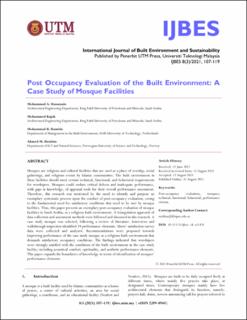| dc.contributor.author | M. Ibrahim, Ahmed | |
| dc.contributor.author | Hassanain, Mohammad A. | |
| dc.contributor.author | Kajak, Mohammed | |
| dc.contributor.author | Hamida, Mohammad B. | |
| dc.contributor.author | Ibrahim, Ahmed M. | |
| dc.date.accessioned | 2021-09-20T06:54:44Z | |
| dc.date.available | 2021-09-20T06:54:44Z | |
| dc.date.created | 2021-09-06T12:37:05Z | |
| dc.date.issued | 2021 | |
| dc.identifier.citation | International Journal of Built Environment and Sustainability (IJBES). 2021, 8 (3), 107-119. | en_US |
| dc.identifier.issn | 2289-8948 | |
| dc.identifier.uri | https://hdl.handle.net/11250/2778996 | |
| dc.description.abstract | Mosques are religious and cultural facilities that are used as a place of worship, social gatherings, and religious events by Islamic communities. The built environment in these facilities should meet certain technical, functional, and behavioral requirements for worshipers. Mosques could endure critical defects and inadequate performance, with gaps in knowledge, of appraisal tools for their overall performance assessment. Therefore, this research was motivated by the need to identify and purpose an exemplary systematic process upon the conduct of post-occupancy evaluation, owing to the fundamental need for satisfactory conditions that need to be met by mosque facilities. Thus, this paper presents an exemplary post-occupancy evaluation of mosque facilities in Saudi Arabia; as a religious built environment. A triangulation approach of data collection and assessment methods were followed and discussed in this research. A case study mosque was selected, following a review of literature. Interviews and walkthrough inspection identified 34 performance elements. Users’ satisfaction survey data were collected and analyzed. Recommendations were proposed towards improving performance of the case study mosque as a religious built environment that demands satisfactory occupancy conditions. The findings indicated that worshipers were strongly satisfied with the conditions of the built environment in the case study facility; including acoustical comfort, spirituality, and aesthetic performance elements. This paper expands the boundaries of knowledge in terms of identification of mosques’ performance elements. | en_US |
| dc.language.iso | eng | en_US |
| dc.publisher | Penerbit UTM Press Malaysia | en_US |
| dc.rights | Navngivelse-Ikkekommersiell-DelPåSammeVilkår 4.0 Internasjonal | * |
| dc.rights.uri | http://creativecommons.org/licenses/by-nc-sa/4.0/deed.no | * |
| dc.title | Post Occupancy Evaluation of the Built Environment: A Case Study of Mosque Facilities | en_US |
| dc.type | Journal article | en_US |
| dc.description.version | publishedVersion | en_US |
| dc.source.pagenumber | 107-119 | en_US |
| dc.source.volume | 8 | en_US |
| dc.source.journal | International Journal of Built Environment and Sustainability (IJBES) | en_US |
| dc.source.issue | 3 | en_US |
| dc.identifier.doi | https://doi.org/10.11113/ijbes.v8.n3.831 | |
| dc.identifier.cristin | 1931599 | |
| dc.description.localcode | This work is licensed under a Creative Commons Attribution-NonCommercial-ShareAlike 4.0 International License. | en_US |
| cristin.ispublished | true | |
| cristin.fulltext | original | |
| cristin.qualitycode | 0 | |

